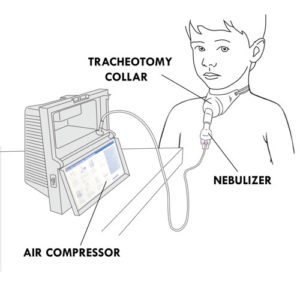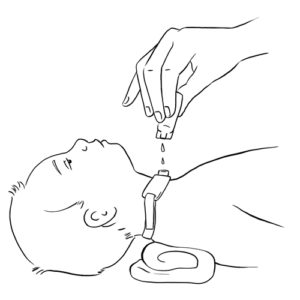Methods on this page:
By a small volume nebulizerBy meter dose inhaler with a spacer
Indications:
- In cases of irritation, inflammation or infection of the respiratory tract, your child may be prescribed medications (eg, antibiotics, bronchodilators) or solutions to be given via the tracheal cannula either by inhalation or instillation.
- Inhaled medications can be administered by nebulization. Nebulization (converting liquid medication into an aerosol) can be produced by a small volume nebulizer or a metered dose inhaler (MDI).
- Instillation is a method of delivering a medication in the form of a liquid or by drops, directly into the tracheal cannula.
- Receiving medication via tracheostomy by inhalation or instillation allows for more targeted therapy and reduces secondary effects to other organs.
- Below is a suggested method that can serve as a guide. Discuss the specific type of medical supplies and equipment used for your child with your child’s healthcare team.
Considerations:
- Some children need suctioning before and/or after the administration of an aerosol treatment. Speak to your child’s healthcare team to know what is appropriate for your child.
- If your child wears a speaking valve or a artificial nose, these devices valve must be removed before administration of therapy (inhaled or by instillation) and replaced afterwards.
- Evaluate the need for a second adult during this procedure to help keep your child in a safe position (eg, if child is young or moves a lot).
- If your child cannot cooperate with the prescribed therapy, consult your child’s healthcare team.
- Good handwashing is essential before and after providing care.
- Ensure the comfort of your child during care by using different positioning and distraction techniques.
Small volume nebulizer:
- Allows delivery of an aerosol treatment.
- A nebulizer is a medical device that contains a medication in liquid form; it is connected to an air compressor that helps to convert the medication into an aerosol that can easily be inhaled into the lungs.
- Different types of nebulizers exist; your child’s healthcare team will recommend the model most appropriate to your child’s needs.
- The nebulizer is connected to the tracheal collar or a T-piece added to the respirator circuit that allows the child to inhale the medication.

Maintenance of the equipment
Below are suggested weekly maintenance methods that can serve as a guide.
Tracheal collar:
- Wash in warm water with a non-perfumed soap; do not use a antibacterial soap.
Compressor and tubing:
- Turn compressor off and disconnect from the electrical wall outlet;
- Clean the exterior of the compressor and the tubing with a damp cloth;
- Never immerse the compressor in water, it will cause damage.
Nebulizer:
- Disassemble the nebulizer and wash the pieces in warm, soapy water;
- Soak 60 minutes in a 1 part white vinegar to 3 parts water solution;
- Rinse thoroughly in water and shake off excess water;
- Let air dry on a clean paper or cloth towel; place the components so that any water will drain out;
- Make sure all components are dry before reassembling;
- Store the equipment in the space provided for this purpose in the air compressor or in a container until the next use.
Equipment replacement
- Replace the tracheal collar and the nebulizer once a month or according to the manufacturer’s recommendations.
- Replace the compressor filter every 6 months or according to the manufacturer’s recommendations.
Metered dose inhaler (puffer) with a spacer:
- Allows delivery of aerosol treatment.
- A metered dose inhaler is a device that allows administration of medication in the form of an aerosol to the lungs.
- A metered dose inhaler is a metal cartridge inserted into a plastic casing; the medication is contained under pressure in the metal cartridge.
- When the cartridge is pushed down, the medication in the cartridge is aerosolized into a puff that can be easily inhaled into the lungs.
- The use of a spacer allows for the fine mist of particles (puff) to slow down and accumulate after the cartridge is pushed downwards, so that the aerosolized medication can then be inhaled in a more coordinated, controlled fashion at your child’s own pace.
- Treatment with a metered dose inhaler is delivered using a specialized spacer adapted for a tracheostomy or via an in-line respirator circuit adapter.

Maintenance of the equipment
Below are general suggestions that can serve as a guide. The frequencies suggested may be different; follow the recommendations of your child’s healthcare team.Metered dose inhaler (once a week):
- Remove the medication cartridge (do not wash the medication cartridge);
- Clean the plastic casing in warm water with non-oily, non-perfumed soap; do not use antibacterial soap; pay particular attention to the plastic casing opening where the medication is aerosolized and where white powder deposits may accumulate;
- Rinse thoroughly in water, shake off excess water;
- Let air dry on a clean paper or cloth towel; place the components so that any water will drain out; without wiping, make sure all components are dry before reassembling;
- Reinsert the cartridge in the plastic casing and store in a clean dry container used solely for this purpose until next use.
Spacer (every 2 weeks):
- Remove the rubber back piece from the spacer;
- Clean all pieces in warm water with non-oily, non-perfumed soap; do not use antibacterial soap;
- Rinse thoroughly in water, shake off excess water; let air dry on a clean paper or cloth towel; place the components in a vertical position so that any water will drain out; without wiping, make sure all components are dry before reassembling;
- Reinsert the rubber back piece on the spacer by pressing firmly and store in a clean dry container used solely for this purpose until next use.
Equipment replacement
- According to the manufacturer’s or your child’s healthcare team’s recommendations.
Instillation
- Instillation is a method of delivering a medication in the form of a liquid or by drops, directly into the tracheal cannula.
- Certain antibiotics can be prescribed and administered by this method.
- In some children, it is sometimes necessary to introduce a small quantity of saline solution, given drop by drop before suctioning to help dislodge secretions that are thick and difficult to clear. Instillation of saline into a tracheal cannula should not be done routinely unless recommended by your child’s healthcare team as this can also flush bacteria further down into the lungs and increase the risk of lung infection.
- Refer to your child’s healthcare team for more information on this method.

Medication storage
- Keep medication in its original packaging, protected from light and at room temperature.
- Metered dose inhalers must be kept at room temperature.
- It is important to store medications according to manufacturer’s and pharmacist’s recommendations.
Frequency:
As prescribed by your child’s healthcare team.
Required materials:
Refer to your child’s healthcare team if the material or the sequence of steps you have been shown is different than those described.








